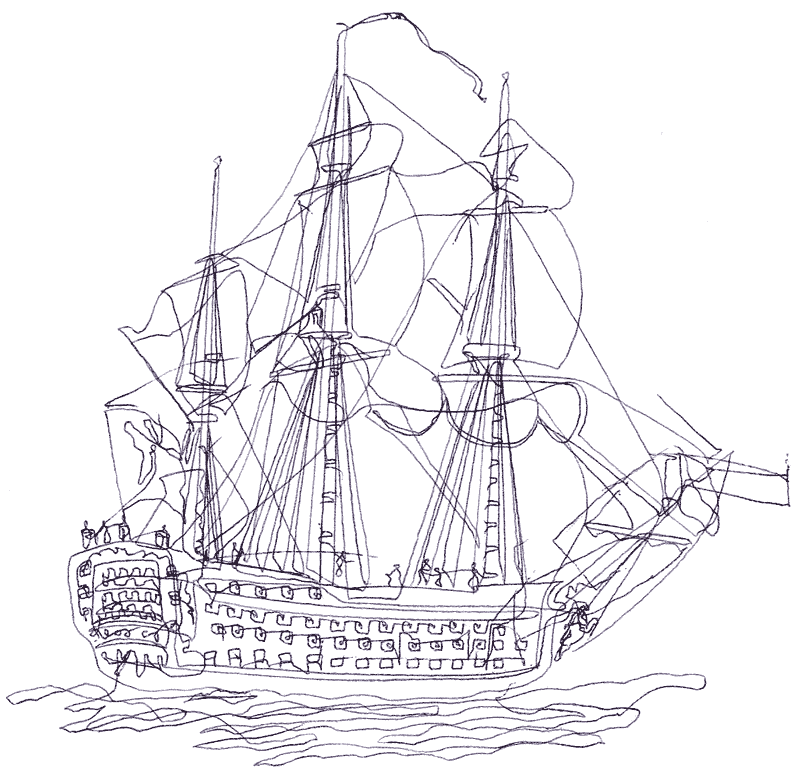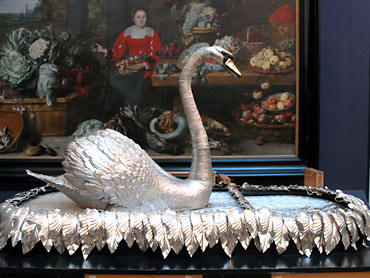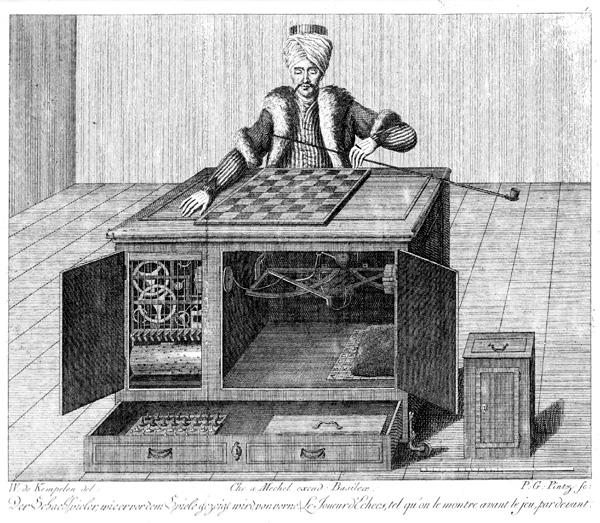The Mechanical Age: Automata between social critique and the uncanny
In 1824, Italian poet and philosopher Giacomo Leopardi (1789-1837) wrote a fictitious announcement to be included in his famous Moral Essays. The imaginary Academy of Syllographs would have awarded a prize to the inventor of any of the following automata: a steam-powered man programmed to do virtuous deeds, a mechanical human able to serve as a trusted friend, and a faithful woman. The construction of these machines, Leopardi said, should not have been considered impossible: judging from the variety of automata able to play chess, draw, and make music, inventors had already succeeded in instilling human qualities in machinery.
Leopardi was right. Around the end of the 18th century and the beginning of the 19th, automata had become real sensations across Europe. French inventor Jacques de Vaucanson (1709-1782), for example, had built a flute-playing machine which was brought on tour around the world even after his death. Attired as a shepherd, the automaton had a repertoire of 12 songs, which he played with realistic motions of the head and of the hands. Vaucanson’s creations, including a tambourine player and a duck digesting food, were so successful that Frederick II of Prussia even proposed that he produce his machinery at his court. Similarly, Swiss watchmaker Pierre Jacquet-Droz (1721-1790) had reached international fame for having built an automaton able to write with pen and ink, as well a drawing machine with the features of a young boy and a musician automaton. A similar automaton had been invented by Maillardet (1745-1830), another Swiss mechanician. Known as the “Juvenile Artist” and now on display in Philadelphia, the machine could write verses as well as drawing, and it was brought on tour in London, Boston, Washington, and New York. Perhaps the most famous of all automata was Kempelen’s (1734-1804) chess-playing Turk, built at the court of Maria Theresa of Austria. The Turk was exhibited in aristocratic circles, where members of the audience would be invited to play a game of chess against the machine. The automaton could move the pieces across the board, as well as make motions with its head and eyes. The human challengers (among whom were Napoleon Bonaparte, Benjamin Franklin, and Charles Babbage himself) almost invariably lost. The machine was later revealed to be a hoax: from a hidden compartment inside its base, a human player could see the game of chess being played above and direct the mechanical arm.

Ship drawn by Maillardet’s automaton (image via Wikipedia)
As argued by Kang in his wonderful book “Sublime dreams of Living Machines,” automata began to feature prominently in Romantic literature at the turn of the 19th century. Their presence in the public imagination made them a suitable prop for social criticism. In his 1789 tale “The Machine-Man and his Characteristics,” satirist and Romantic writer Jean Paul imagined a planet where the lord of the mechanical world, the Machine-Man, carried out even the simplest tasks with the aid of machinery: he had machines to chew food, machines to write letters, machines to say his prayers, and the automata of Vaucanson and Jaquet-Drotz to play music for him.[1]
“The Machine man” and Leopardi’s “Announcement from the Academy of Syllographs” are obvious criticisms of industrialisation and mechanisation (we must remember that these pieces were written in times of important industrial changes at the European level), and they voice concerns about the ever-increasing dependency of mankind on machinery, which may ultimately have led to the substitution of the former with the latter. Interestingly, although for obvious satiric purposes such substitution is presented in favourable terms in Leopardi’s essay, he is convinced that “it would be easier to remake mankind altogether from a new mold or to replace it with another kind than to amend it.”[2] Moreover, Jean Paul’s “The Machine Man” stresses the dehumanisation associated with mechanisation: the short story was rewritten to be inserted in another collection, and in this version the Machine-Man became a Machine-King, an absolute monarch reigning over human subjects reduced to mere cogs in a system and therefore deprived of their humanity and agency.
Automata provided avenues for social criticism not only towards the absolute monarchy or the mechanization of society, but also toward the aristocracy in whose circles automata were displayed. In a play by Büchner (1813-1837), Kang points out how two (assumed) automata are described to ridicule the habits of the high society. These automata, Büchner writes, are “very well born, because they speak High German; they are very moral, because they rise punctually at the stroke of a bell, because they eat punctually at the stroke of midday, and because they retire punctually at the stroke of another bell (…). Pay attention now, ladies and gentlemen, for they are now in an interesting stage of their development: the mechanism of love is beginning to set itself in motion. The gentleman had already given the lady her scarf a number of times, and several times now the lady has rolled her eyes and turned them toward heaven.”[3] (my emphasis)
The etiquette of the aristocracy, as well as their feelings, appear here as being as rigid and structured, mechanical and artificial as clockwork. This form of satire recurs also in Jean Paul’s “Most humble remonstrance of all players and talking ladies in Europe against the introduction of von Kempelen’s playing and talking automata” (1789), in which the theme of the substitution of human beings with machines is reinterpreted: this time it is the ladies of the aristocracy, and not the workers in factories, who are afraid of being substituted by automata, as their behavior is so unoriginal, contrived, mechanical and unhuman that machines could easily replace them.
It appears that what lies at the base of the sensation caused by automata is not an exclusive technological concern with their spectacular displays of ingenuity. As shown by the examples above, through the automaton, the humanity itself of industrialisation, of absolute monarchy, and of the nobility is being questioned. In virtue of their fundamentally uncanny nature, automata constitute an excellent tool for this challenge: they themselves lie at the border between the human and the nonhuman, the natural and the artificial, between life and its simulation. This unsettling elusion becomes particularly evident in Leopardi’s “Announcement”: on one side, automata are the twisted product of a society in which technological progress has reached an unprecedented level, while on the other they are supposed to replicate the qualities (trustworthiness, faithfulness, magnanimity) that humans have lost while distancing themselves from the happiness and simplicity of the state of nature. Even so, they are criticised for being the only means that a society can find to improve itself, understanding mechanization as the only possible form of salvation and progress.

John Joseph Merlin’s silver swan, now housed at the Bowes Museum (image via Bowes Museum)
A further proof of the uncanny nature of automata can be acquired from the reactions found in contemporary accounts about the exhibition of these machines. On seeing John-Joseph Merlin’s (1735-1803) Mechanical Swan on display (do take time to watch it in action here), Mark Twain described it thus:
I watched the Silver Swan, which had a living grace about his movement and a living intelligence in his eyes – watched him swimming about as comfortably and unconcernedly as he had been born in a morass instead of a jeweller’s shop – watched him seize a silver fish from under the water and hold up his head and go through the customary and elaborate motions of swallowing it…[4] (my emphasis)
In this passage, the machine is described with the pronouns and connotations one would use when describing a real animal, an intelligent creature endowed with agency, swimming about and catching fish, and not a mechanical device. A similar example comes from the description of Napoleon’s reactions while playing chess against Kempelen’s Turk in 1809. Napoleon tried to trick the automaton by making a few illegal moves. The machine responded by placing the pawn in the correct place, by removing it from the board, or by knocking off all the pieces in anger. Napoleon is also said to have tried to prevent the machine from seeing by covering its head with cloth. Although the accounts vary, it is still interesting that they reveal a concern with the humanity of the machine, as Napoleon thought to cover its face as he would have done with a living player sitting before him.

1783 copper engraving of Wolfgang von Kempelen’s chess-playing Turk (image via Wikipedia)
A last piece highlighting similar aspects comes from John Griscom’s journal A Year in Europe (1924), a collection of observations made between 1818 and 1819. It contains the following passage about one of Droz’s clocks:
…when the clock struck, the shepherd played six tunes on his flute, and the dog approached and fawned upon him. This clock was exhibited to the King of Spain, who was delighted with it. “The gentleness of my dog,” said Droz, “is his least merit; if your Majesty touch one of the apples, which you see in the shepherd’s basket, you will admire the fidelity of this animal.” The King took an apple, and the dog flew at his hand, and barked so loud, that the King’s dog, which was in the room, began also to bark; at this the Courtiers, not doubting that it was an affair of witchcraft, hastily left the room, crossing themselves as they went out. The minister of Marine was the only one that ventured to stay. (One of the automata on the clock, when asked the time, replies in French). At this new prodigy the firmness of the minister also forsook him, and he retreated precipitately declaring that it must be the work of the devil.[5] (my emphasis)
This passage highlights two particular aspects which characterize the automaton as a fundamentally unsettling entity. The first is, once more, its lifelike quality: the dog barks, responding to an external stimulus and therefore appearing aware of its surroundings. Not only that: in a complete blurring of the divide between the natural and the artificial, the sounds emitted by the animal are so realistic that a real dog barks back. The second aspect is represented by the statuette replying to the King’s question, thus demonstrating that it possesses a capability for speech. The fact that the capability for human language, instead of being a simple imitation, is taken for witchcraft even by the bravest among the ministers testifies that such faculty, coming from an inanimate object, marks the infringement of a boundary, the accomplishment of an illegitimate act, an aberration, perhaps also in virtue of the association between the capacity for language and the capacity for thought. Interestingly, Kempelen himself, the inventor of the Turk, was researching to endow automata with speech. Leopardi ridicules these attempts by rhetorically observing that making automata speak should not be considered difficult, since even a creature as simple as a parrot can speak. The anxieties surrounding the capacity for language are also found in Hoffmann’s tale “The Automaton” (1814), in which two friends see an automaton, exhibited as a curiosity, which can answer questions about the future of its interlocutors. This tale is used by Kang to point out how in Romantic times, instead of being a mere curiosity or a display of mechanical mastery, the automaton began to be increasingly associated with witchcraft and the occult, so that its uncanniness acquired a mysterious, almost magical connotation.
Automata occupied an important place in the imagination of the 18th and early 19th century. Being the products of a society increasingly concerned with industrialisation and mechanisation, and being exclusive objects associated to the circles of the nobility, automata constituted an excellent avenue for social critique. Moreover, placed as they were between life and artificiality, technology and the occult, man and machine, automata fascinated the audiences and repelled them, problematizing the divide between the human and the non-human.
[1] Kang, M. 2011. Sublime dreams of living machines: the automaton in the European Imagination. London: Harvard University Press. P.202.
[2]Leopardi, G. 1983. Operette Morali: Essays and dialogues. Berkeley: University of California Press. p.79.
[3] Büchner mentioned in Kang, 205. The automata in the play are revealed to be actual human beings.
[4] Twain, M. 1984. The Innocents Abroad – Roughing It. New York: Literary Classics of the United States. P.100.
[5] Griscom, John. 1824. A Year In Europe. New York: Collins and Hannay. Pp.297-298.



Dilettante Mail
Get updates from us a few times a year.